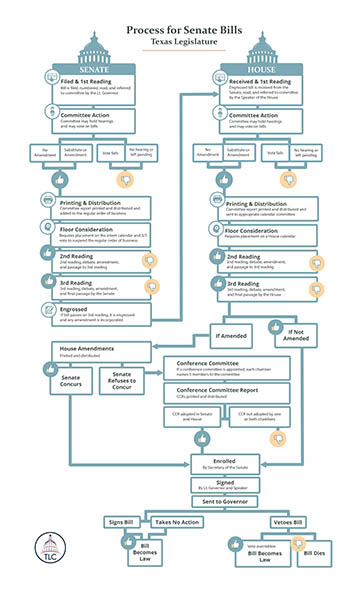How a Bill Becomes a Law
Oct 14
The Texas Constitution and the Rules of the House and Senate set the procedure that a bill must follow in order to be passed into law. Here are the basic steps in the legislative process:
- Bill filing/introduction
- First reading and referral to committee
- Committee consideration
- Floor consideration on second and third reading
- Engrossment
- Consideration in opposite chamber
- Concurrence in opposite chamber's amendments, or conference committee report
- Sent to Governor
- Governor signs bill or takes no action
- Bill becomes law on effective date
Bills that do not pass or are vetoed by the Governor must be reintroduced the next session; the bill number does not carry over.
Several key publications describing the Texas legislative process are available on the Legislative Reference Library website under General Information | Texas legislative agencies & process, including:
Bill process flowcharts for the House and Senate. Online versions are available through the Texas Legislative Council.
The Legislative Process in Texas, by the Texas Legislative Council (November 2018), details each step in the legislative process, from how a bill originates to the filing and publication of laws.

Citizen Handbook: How the Texas Legislature Works, published by the Secretary of the Senate (February 2019), includes a short history of the Texas Capitol, an overview of the Texas Senate and Texas House of Representatives, legislative advocacy tips, and basic steps in the legislative process.
The Legislative Lexicon, by the Senate Research Center (January 2019), explains the vocabulary of the legislature from A-Z, such as the difference between an engrossed and enrolled bill.
How a Bill Becomes Law: 86th Legislature, by the House Research Organization (February 28, 2019), provides an overview of the legislative process with a focus on House rules.





